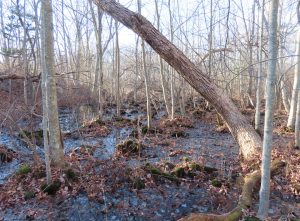FULL SET: https://www.facebook.com/media/set?vanity=sigrun.gadwa.56&set=a.610140136753118
Photos show a low-lying coastal forest in Old Lyme, Connecticut, on a forested ~fifteen-acre “peninsula” bordered by brackish marsh. It is just east of the Connecticut River and north of the Amtrak RR line. Upland forest is mostly limited to roadsides and embankments, but has the full suite of species typical of this forest community, as described below in a Sea Grant (UConn) Fact Sheet. So little Coastal Forest remains in this state , due to coastal development and farming, that it has been designated a Critical Habitat by CTDEEP.
https://climate.uconn.edu/coastal-resources/forests/
COASTAL FORESTS
Coastal forests are found along the coast and are subject to a maritime climate. These forests do not receive daily salt spray (as a true maritime forest may), but can be subject to wind and salt spray during storm events.
VEGETATION
Oak trees, particularly black, white, chestnut and scarlet, are the dominant trees of these forests. Other trees that may be intermixed with the oaks include black cherry, sassafras, red maple, beech, tupelo, white pine and pitch pine. Low lying shrubs such as low bush blueberries and black huckleberry. Vines are very characteristic of coastal forest edges and openings including Virginia creeper, poison ivy, grape and greenbriers. (I would add hackberry and American Holly, as characteristic trees, and bayberry, a salt tolerant native shrub.)
WHY THEY ARE IMPORTANT
Due to intense agricultural and development pressures, Connecticut has very little forest left within the coastal zone. What is left is often heavily browsed by deer and invaded by non-native species. Raising awareness of where and what these forests are will aid in protection and restoration efforts.



